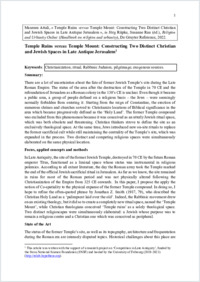Temple Ruins versus Temple Mount : Constructing Two Distinct Christian and Jewish Spaces in Late Antique Jerusalem
BHAP-HA+SCANT
- Attali, Maureen ORCID University of Fribourg
- 2022
Published in:
- Religion and Urbanity Online / Rüpke, Jörg ; Rau, Susanne. - De Gruyter Reference. - 2022
English
There are a lot of uncertainties about the fate of former Jewish Temple’s site during the Late Roman Empire. The status of the area after the destruction of the Temple in 70 CE and the refoundation of Jerusalem as a Roman colony in the 130’s CE is unclear. Even though it became a public area, a group of people defined on a religious basis – the Jews – were seemingly normally forbidden from entering it. Starting from the reign of Constantine, the erection of numerous shrines and churches served to Christianize locations of Biblical significance in the area which became progressively defined as the ‘Holy Land’. The former Temple compound was excluded from this phenomenon because it was conceived as an utterly Jewish ritual space, which was both obsolete and threatening. Christian thinkers strove to define the site as an exclusively theological space. At the same time, Jews introduced new on-site rituals to replace the former sacrificial cult while still maintaining the centrality of the Temple’s site, which was expanded in the process. Two distinct and competing religious spaces were simultaneously elaborated on the same physical location.
- Faculty
- Faculté des lettres et des sciences humaines
- Department
- Département d'histoire
- Language
-
- English
- Classification
- Ancient history
- License
- License undefined
- Open access status
- green
- Identifiers
- Persistent URL
- https://folia.unifr.ch/unifr/documents/312385
Statistics
Document views: 164
File downloads:
- attali_2022_temple.pdf: 214
